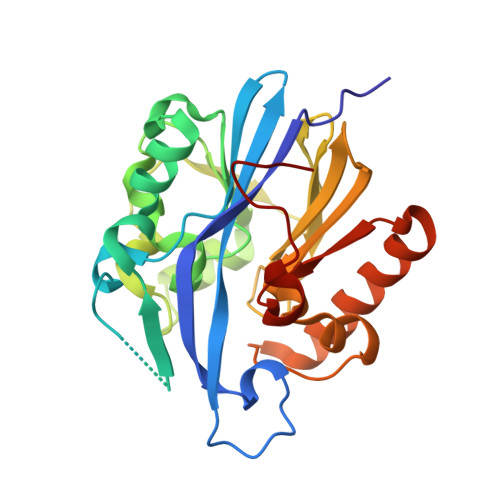The Molecular Structure and Catalytic Mechanism of a Quorum-Quenching N-Acyl-L-Homoserine Lactone Hydrolase.
Kim, M.H., Choi, W.C., Kang, H.O., Lee, J.S., Kang, B.S., Kim, K.J., Derewenda, Z.S., Oh, T.K., Lee, C.H., Lee, J.K.(2005) Proc Natl Acad Sci U S A 102: 17606
- PubMed: 16314577
- DOI: https://doi.org/10.1073/pnas.0504996102
- Primary Citation of Related Structures:
2BR6, 2BTN - PubMed Abstract:
In many Gram-negative bacteria, including a number of pathogens such as Pseudomonas aeruginosa and Erwinia carotovora, virulence factor production and biofilm formation are linked to the quorum-sensing systems that use diffusible N-acyl-L-homoserine lactones (AHLs) as intercellular messenger molecules. A number of organisms also contain genes coding for lactonases that hydrolyze AHLs into inactive products, thereby blocking the quorum-sensing systems. Consequently, these enzymes attract intense interest for the development of antiinfection therapies. However, the catalytic mechanism of AHL-lactonase is poorly understood and subject to controversy. We here report a 2.0-angstroms resolution structure of the AHL-lactonase from Bacillus thuringiensis and a 1.7-angstroms crystal structure of its complex with L-homoserine lactone. Despite limited sequence similarity, the enzyme shows remarkable structural similarities to glyoxalase II and RNase Z proteins, members of the metallo-beta-lactamase superfamily. We present experimental evidence that AHL-lactonase is a metalloenzyme containing two zinc ions involved in catalysis, and we propose a catalytic mechanism for bacterial metallo-AHL-lactonases.
Organizational Affiliation:
Korea Research Institute of Bioscience and Biotechnology, Yusong, Daejon 305-600, Korea.
















